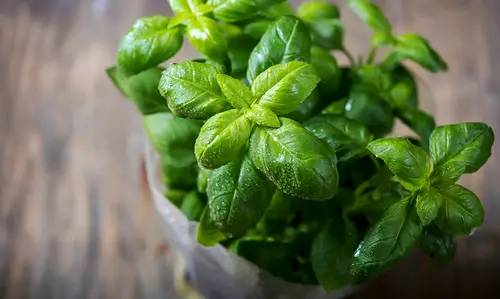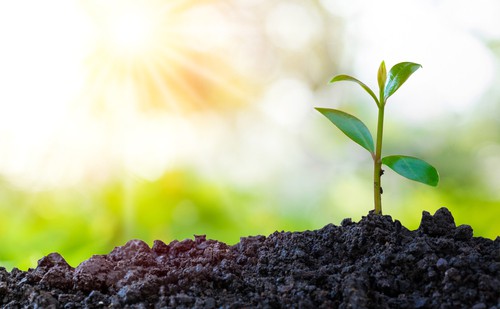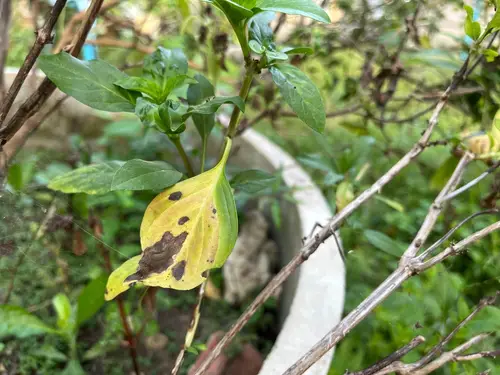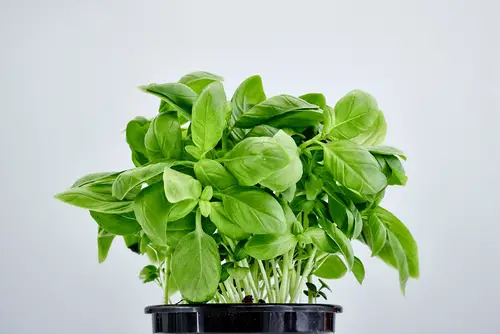Basil is a popular herb used in various dishes worldwide, known for its unique flavor and aroma. However, if you notice your basil stems turning brown, it can be a cause for concern. Brown basil stems can be a sign of several factors, including disease, pest infestation, or improper care.
Understanding the reasons behind brown basil stems can help you take appropriate measures to prevent further damage and ensure the longevity of your basil plant.
Basil plants require specific growing conditions to thrive, including the right amount of water, sunlight, and nutrients. Even minor changes in these factors can cause the basil stems to turn brown. Overwatering or underwatering can lead to root rot or drying out of the plant, respectively, causing the stems to turn brown.
Similarly, inadequate light or high temperatures can also impact the plant’s health, leading to brown stems. While aging and overgrowth are natural causes of brown basil stems, proper maintenance and care can help prevent premature discoloration.
Key Takeaways on Basil Stems Turning Brown
- Brown basil stems can be a sign of various factors, including disease, pest infestation, or improper care.
- Basil plants require specific growing conditions to thrive, including the right amount of water, sunlight, and nutrients.
- Proper maintenance and care can help prevent premature discoloration of basil stems.
Check out these other top picks:
- Why Are My African Violet Leaves Turning Brown?
- Why Are My Zinnia Leaves Turning Brown?
- Staghorn Fern Leaves Turning Brown:
Understanding Basil Plants

Basil (Ocimum basilicum) is a popular herb that is commonly used in cooking and for medicinal purposes. It is a member of the mint family and is known for its fragrant leaves, which are used to add flavor to a variety of dishes. Basil plants are relatively easy to grow and can be grown indoors or outdoors in a variety of climates.
Basil plants have a life cycle that typically lasts for one growing season. They begin as seeds and grow into small seedlings, which eventually develop into mature plants. As the plant grows, it produces foliage and flowers, which can be harvested for culinary or medicinal purposes.
One of the most common issues that basil growers face is the browning of the plant’s stems. This can occur for a variety of reasons, including age, disease, or improper care. As basil plants age, their stems may naturally turn brown and dry up. This is a sign that the plant is reaching the end of its life cycle and is preparing to produce seeds.
In addition to age, basil plants can also develop brown stems as a result of disease or improper care. Fungal infections, such as downy mildew, can cause the leaves and stems of the plant to turn yellow and eventually brown. Overwatering or underwatering the plant can also cause the stems to turn brown and dry out.
To prevent the browning of basil stems, it is important to provide the plant with proper care. This includes ensuring that the plant is watered regularly but not overwatered, providing it with adequate sunlight, and keeping it free from pests and disease.
Regularly harvesting the plant’s foliage can also help to promote healthy growth and prevent the plant from becoming too woody.
Why Basil Stems Turn Brown
Basil stems may turn brown due to various reasons, including natural maturity, fungal infections, improper watering, lack of sunlight, pests, or diseases. In some cases, the discoloration of the stems may happen prematurely, requiring immediate intervention to save the plant.
One of the most common causes of browning basil stems is improper watering. Basil requires adequate water to stay alive, and without it, the plant will begin to dry out, leading to brown and woody stems. Overwatering can also cause the stems to turn brown and rot, as basil plants are sensitive to excess moisture.
Another reason for browning basil stems could be a lack of sunlight. Basil requires at least six hours of sunlight daily to thrive. Without enough sunlight, the plant may become weak and stressed, leading to brown and woody stems.
Fungal infections can also cause basil stems to turn brown and mushy. Fungal diseases such as root rot can affect the plant’s health, leading to discoloration, wilting, and eventual death. Proper drainage and good air circulation can help prevent fungal infections in basil plants.
Pests such as aphids, spider mites, and whiteflies can also cause stress to basil plants, leading to brown and woody stems. These pests feed on the plant’s sap, causing damage to the leaves and stems. Regular inspection and treatment with appropriate pesticides can help prevent pest infestations.
Role of Watering

Watering is one of the most important factors that affect the health of a basil plant. Basil requires a consistent supply of water to grow, but too much or too little water can cause the stems to turn brown.
Overwatering is a common cause of brown basil stems. When the plant receives too much water, the roots become waterlogged and cannot absorb the nutrients they need to survive.
This can cause the roots to rot, which in turn can lead to brown stems and leaves. To prevent overwatering, it is important to ensure that the soil is well-draining and not watered too frequently.
On the other hand, if a basil plant is underwatered, it can also cause the stems to turn brown. When a plant does not receive enough water, it can become stressed and begin to wilt.
This can cause the leaves and stems to become dry and brittle, leading to brown stems. To avoid underwatering, it is important to water the plant consistently and ensure that the soil is not allowed to dry out completely.
Another issue that can arise from improper watering is root rot. This occurs when the roots of the basil plant are exposed to too much moisture for an extended period of time.
The roots will begin to rot, which can cause the stems to turn brown and the plant to die. To prevent root rot, it is important to ensure that the soil is well-draining and that the plant is not overwatered.
Soil and Pot Requirements
The soil and pot requirements are critical factors when it comes to growing healthy basil plants. The soil should be well-draining, rich in nutrients, and have a pH level between 6.0 and 7.5. Basil plants prefer a soil that is slightly moist but not waterlogged.
It is essential to use a pot that is the right size for the basil plant. The pot should be big enough to accommodate the roots and allow for proper growth. A pot that is too small can cause the soil to dry out quickly, leading to brown stems and wilted leaves.
Another critical factor to consider is the drainage hole in the pot. The pot should have a drainage hole at the bottom to allow excess water to drain out. If the pot does not have a drainage hole, the soil can become waterlogged, leading to root rot and brown stems.
Containers made of materials such as plastic, clay, or ceramic can be used to grow basil. However, it is essential to ensure that the container is clean and free of any harmful chemicals that can affect the plant’s growth.
The roots of the basil plant require oxygen to grow properly. Therefore, it is essential to avoid overwatering the plant, as this can lead to waterlogged soil and suffocate the roots. On the other hand, underwatering can cause the soil to dry out, leading to brown stems and wilted leaves.
In summary, selecting the right soil and pot, ensuring proper drainage, and avoiding over or underwatering are crucial factors when it comes to preventing brown stems in basil plants.
Light and Temperature Factors

Basil plants require adequate light and temperature to grow healthy and produce good yields. Light and temperature factors can significantly affect the growth and development of basil plants, including the color of the stems. Here are some of the factors to consider:
Light
Basil plants require plenty of light to grow healthy and produce good yields. They need at least 6-8 hours of direct sunlight per day. Insufficient light can lead to weak and spindly plants, which can cause the stems to turn brown and dry up.
If you’re growing basil indoors, make sure to place the plants near a south-facing window where they can receive plenty of sunlight. Alternatively, you can use grow lights to supplement natural light. Grow lights should be placed 6-12 inches above the plants and turned on for 12-16 hours per day.
Temperature
Basil plants prefer warm temperatures between 70-85°F (21-29°C). Temperatures below 50°F (10°C) can cause the leaves and stems to turn brown and drop off. Hot weather, on the other hand, can cause the plants to wilt and become stressed, leading to brown stems.
If you’re growing basil outdoors, make sure to plant them in a spot that receives plenty of sunlight but is protected from strong winds and extreme temperatures. If you’re growing basil indoors, use a heat mat to maintain a consistent temperature of around 70°F (21°C).
Disease and Pest Impact
Basil plants are susceptible to various pests and diseases that can cause the stems to turn brown. These pests and diseases can have a significant impact on the health and growth of the plant.
One of the most common basil pests is aphids. These small, soft-bodied insects stick to the underside of the leaves and stems of the basil plant, sucking out the sap.
They spread a sticky substance over the plant called honeydew that attracts sooty mold and ants that will cause further damage. Aphids can be controlled with insecticide or by using natural remedies such as neem oil.
Downy mildew is another prevalent disease that affects basil. Yellow leaves that eventually turn brown will be the first sign that your basil has downy mildew.
Additionally, you’ll see that your basil plant is wilting, drooping, and producing fuzzy growth on the undersides of its leaves. Downy mildew can be prevented by providing good air circulation, avoiding overhead watering, and using a fungicide.
Fusarium wilt is a fungal disease that can cause brown spots on the stems of basil plants. The fungus invades the plant’s vascular system, causing the leaves to wilt and the stems to turn brown. Fusarium wilt can be prevented by using sterilized soil, avoiding overhead watering, and removing infected plants immediately.
Other fungal infections can also cause brown spots and stem rotting on basil plants. These fungi can be prevented by providing good air circulation, avoiding overhead watering, and using a fungicide.
Identifying Nutrient Deficiencies

Basil stems can turn brown due to nutrient deficiencies. Nutrients are essential for the growth and development of plants. A lack of nutrients can lead to stunted growth, discoloration, and other problems. Here are some common nutrient deficiencies that can cause basil stems to turn brown:
Nitrogen Deficiency
Nitrogen is an essential nutrient for plant growth and development. A lack of nitrogen can cause the leaves and stems to turn yellow or brown. In severe cases, the leaves may fall off.
Nitrogen deficiency can be caused by poor soil quality, lack of fertilizer, or overwatering. To prevent nitrogen deficiency, make sure to use high-quality soil and fertilizers that are rich in nitrogen.
Vitamin Deficiencies
Basil plants require several vitamins to grow and develop properly. A lack of vitamins can cause the leaves and stems to turn brown. For example, a lack of vitamin B12 can cause the leaves to turn brown and fall off. To prevent vitamin deficiencies, make sure to provide your basil plant with a balanced diet of nutrients.
Antioxidant Deficiencies
Antioxidants are important for plant growth and development. They help protect the plant from damage caused by free radicals and other harmful substances. A lack of antioxidants can cause the leaves and stems to turn brown. To prevent antioxidant deficiencies, make sure to provide your basil plant with a diet rich in antioxidants.
In conclusion, nutrient deficiencies can cause basil stems to turn brown. Nitrogen, vitamins, and antioxidants are essential for plant growth and development. By providing your basil plant with a balanced diet of nutrients, you can prevent nutrient deficiencies and keep your plant healthy and thriving.
Maintenance and Care
To prevent basil stems from turning brown, proper maintenance and care are essential. Here are some tips to help you cultivate healthy basil plants:
1. Watering
Basil requires consistent moisture to thrive, but overwatering can lead to root rot and brown stems. It’s best to water basil deeply once or twice a week, depending on the weather conditions and soil type. Make sure the soil is well-draining and not too compacted.
2. Sunlight

Basil needs at least six hours of direct sunlight per day to grow healthy and strong. Make sure to place your basil plant in a sunny location where it can receive enough light. If you’re growing basil indoors, consider using grow lights to supplement natural light.
3. Fertilizer
Basil requires regular feeding to maintain its health and vigor. Use a balanced fertilizer every two to three weeks during the growing season to provide the necessary nutrients. Avoid over-fertilizing, as this can lead to burnt leaves and brown stems.
4. Trimming and Pruning
Regular trimming and pruning can help prevent basil stems from turning brown. Pinch off the top two sets of leaves when the plant reaches six inches in height to encourage bushier growth. Trim off any yellow or brown leaves as soon as you notice them to prevent the spread of disease.
5. Pest Control
Basil is susceptible to a variety of pests, including aphids, spider mites, and whiteflies. Regularly inspect your plants for signs of infestation, such as yellowing leaves or sticky residue. Use organic pest control methods, such as neem oil or insecticidal soap, to treat any pest problems.
By following these maintenance and care tips, you can prevent and treat brown stems on your basil plant. With proper care, your basil will thrive and provide you with delicious, fresh herbs for your cooking needs.
Signs of Aging and Overgrowth
As basil plants age, their stems may start to turn brown. This is a natural process that occurs as the plant grows and matures. Overgrowth can also cause the basil stems to turn brown. When a basil plant becomes too large, it can become stressed, which can cause the stems to turn brown and the leaves to wilt.
Oxidation can also cause the basil stems to turn brown. When the plant is exposed to air, the enzymes in the plant cells can react with oxygen, causing the plant to turn brown. This is why it is important to store cut basil in an airtight container in the refrigerator.
When a basil plant begins to flower, the stems may turn brown. This is a sign that the plant is reaching the end of its life cycle. Once a basil plant has blossomed, it will begin to go dormant. During this time, the plant may appear dead, with brown stems and wilted leaves.
Winter can also cause basil stems to turn brown. When the plant is exposed to cold temperatures, it can become stressed, which can cause the stems to turn brown and the leaves to wilt. Dead branches may also cause the stems to turn brown. It is important to prune dead branches from the plant to prevent the spread of disease.
Observing Leaf Changes

When it comes to basil plants, observing leaf changes is an essential part of maintaining their health. One of the most common issues that basil growers encounter is brown stems, which can be a sign of several underlying problems. However, before addressing the issue, it is crucial to examine the leaves for any other changes.
Yellowing leaves are a common symptom of many plant problems, including overwatering, underwatering, and nutrient deficiencies. If the leaves of the basil plant start turning yellow, it may indicate that the plant is not receiving enough nutrients, or it is being overwatered.
On the other hand, if the leaves are yellowing and dropping, it may indicate a more severe problem, such as a disease or pest infestation.
In addition to yellowing, brown leaves are another common symptom of basil plant problems. Brown leaves can be caused by a variety of issues, including overwatering, underwatering, temperature stress, pests, or diseases.
If the brown leaves are limited to just a few branches, it may indicate a localized problem, such as an insect infestation or fungal disease. However, if the brown leaves are widespread, it may indicate a more severe problem, such as a nutrient deficiency or root rot.
Leaf spot is another issue that can affect basil plants. Leaf spot is a fungal disease that causes brown spots to appear on the leaves. The spots may be small or large, and they may be surrounded by a yellow halo. If left untreated, leaf spot can cause the leaves to drop, and the plant may eventually die.
Frequently Asked Questions
How can I prevent my basil stems from turning brown?
To prevent basil stems from turning brown, ensure that the plant is getting enough water but not too much. Water the plant when the top inch of soil is dry to the touch.
Avoid overhead watering, which can cause fungal infections. Additionally, ensure that the plant is getting enough sunlight and that the soil is well-draining.
What causes basil stems to turn brown?
Basil stems can turn brown due to various reasons, including fungal infections, overwatering, underwatering, and cold temperatures. Fungal infections are most common and are caused by high humidity levels, poor airflow, and wet soil.
Overwatering can cause root rot, which can lead to brown stems. Underwatering can cause the plant to dry out and die. Cold temperatures can also cause the plant to wilt and turn brown.
What is the best way to fix woody basil stems?
The best way to fix woody basil stems is to prune the plant regularly. Pruning encourages new growth and prevents the plant from becoming too woody. Additionally, ensure that the plant is getting enough sunlight and water.
Should I cut off brown leaves from my basil plant?
Yes, it is recommended to cut off brown leaves from the basil plant. Brown leaves can indicate a fungal infection or other issues and can spread to other parts of the plant. Cutting off the brown leaves can also encourage new growth.
What does overwatered basil look like?
Overwatered basil may have yellowing leaves that are soft and mushy to the touch. The soil may also be waterlogged, and the plant may have a foul odor. Overwatering can cause root rot, which can lead to the plant’s death.
Is it safe to eat basil when it turns brown?
It is not recommended to eat basil when it turns brown. Brown leaves can indicate a fungal infection or other issues and can affect the plant’s flavor and texture. It is best to cut off the brown parts and discard them.


